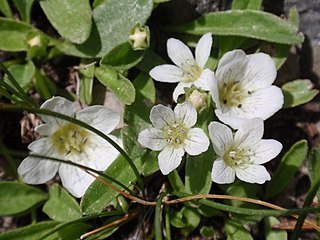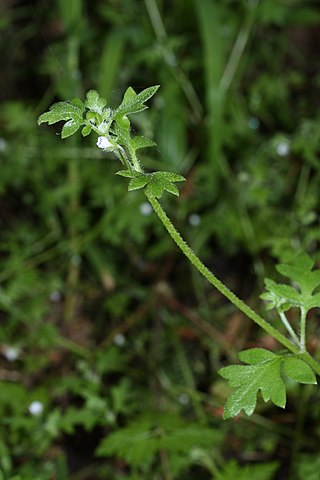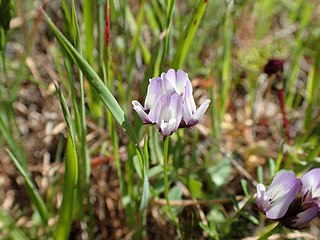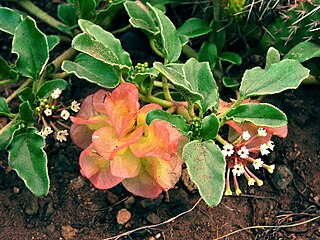
Nemophila is a genus found in the flowering plant family Boraginaceae.

Marah fabacea, the California manroot or bigroot, is the most common of the manroot species native to California. Its range throughout the state subsumes nearly the entire ranges of all the other California native manroots species and intergrades. Hybrids between California manroot and other species of Marah are common.

Marah oreganus, the Oregon manroot, coastal manroot or western wild-cucumber, is a common manroot of the northwest coast of the United States. It ranges from California north to Canada.

Layia platyglossa, commonly called coastal tidytips, is an annual wildflower of the family Asteraceae, native to western North America.

Nemophila spatulata, with the common names Sierra baby blue-eyes and Sierra nemophila, is a dicot in the family Boraginaceae.

Marah macrocarpa, known as chilicothe, wild cucumber, manroot or bigroot is a species of plant in the genus Marah.

Platystemon is a monotypic genus of flowering plants in the poppy family containing the single species Platystemon californicus, which is known by the common name creamcups. It is native to Oregon, California, Arizona, Utah and Baja California, and is found in open grasslands and sandy soils below 6,000 feet (1,800 m) elevation.

Nemophila parviflora, the smallflower nemophila, small-flowered nemophila or oak-leaved nemophila, is a dicot in the borage family, Boraginaceae, in the waterleaf subfamily, Hydrophylloideae.

Gentiana newberryi is a species of gentian known by the common names alpine gentian and Newberry's gentian. It is a perennial herb found in western North America.

Geranium carolinianum is a species of geranium known by the common name Carolina crane's-bill, or Carolina geranium. This species is native to North America, where it is widespread and grows in many types of habitat. There are two varieties; Geranium carolinianum var. carolinianum and the Geranium carolinianum var. sphaerospermum. This is a summer or winter annual herb. It can be considered invasive depending on the region, when it is found in the United States it is considered to be native.

Astragalus breweri is a species of milkvetch known by the common name Brewer's milkvetch. It is endemic to northern California, where it is found in several counties surrounding the north edge of the San Francisco Bay Area. It grows in open habitat in the North Coast Ranges, sometimes on serpentine soils.

Caulanthus pilosus is a species of flowering plant in the family Brassicaceae known by the common names hairy wild cabbage and chocolate drops. It is native to open, dry habitat in the Great Basin of Nevada, the Eastern slope of the Sierra Nevada to 9,000 ft (2,700 m) and surrounding regions of the United States northward to the SE corner of Oregon. It is an annual or occasionally perennial herb coated in thin hairs, especially toward the base.
Mentzelia affinis is a species of flowering plants in the family Loasaceae known by the common name yellowcomet. It is native to the southern half of California, Arizona, and adjacent sections of Nevada and Baja California, where it is known from scrub, woodland, desert sands, and other habitat types.
Nemophila breviflora is a species of flowering plant in the borage family known by the common names basin nemophila, Great Basin nemophila, and Great Basin baby-blue-eyes. It is native to southwestern Canada and the northwestern United States, where it generally grows in wooded and forested areas in thickets and moist streambanks.

Nemophila heterophylla is a species of flowering plant in the borage family known by the common name small baby blue eyes.
Nemophila pulchella, known by the common name Eastwood's baby blue-eyes, is a species of flowering plant in the borage family. It is endemic to California, where it is found from the San Francisco Bay Area to the southern Sierra Nevada to the Transverse Ranges. It grows in many types of mountain, foothill, and valley habitats.

Pedicularis centranthera is a species of flowering plant in the family Orobanchaceae known by the common names dwarf lousewort and Great Basin lousewort. It is native to the western United States from eastern Oregon and California to Colorado and New Mexico, where it grows in sagebrush and other basin and plateau habitat. It is a perennial herb producing several short stems a few centimeters tall from a basal caudex. The leaves are up to 20 centimeters long, lance-shaped and divided into many overlapping toothed, wrinkled, or fringed lobes. The inflorescence is a short raceme bearing many long, protruding, club-shaped flowers. Each flower may exceed 4 centimeters in length and is white or pale purple with dark purple tips on the wide ends of its upper and lower lips. The sepals of the flowers are shorter and hairy. The fruit is a capsule around centimeter long containing seeds with netlike surfaces.

Phacelia tanacetifolia is a species of flowering plant in the borage family Boraginaceae, known by the common names lacy phacelia, tansy-leaf phacelia, blue tansy, purple tansy or fiddleneck (UK).

Plagiobothrys nothofulvus is a species of flowering plant in the family Boraginaceae known by the common names rusty popcornflower and foothill snowdrops. It is native to western North America from Washington, and California, to northern Mexico. It is a spring wildflower in grassy meadows, woodlands, coastal sage scrub, and wetland-riparian habitats.

Tripterocalyx micranthus is a species of flowering plant in the four o'clock family known by the common names smallflower sandverbena and small-flowered sand-verbena.

















